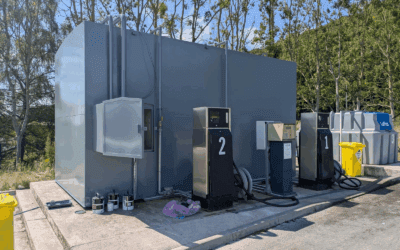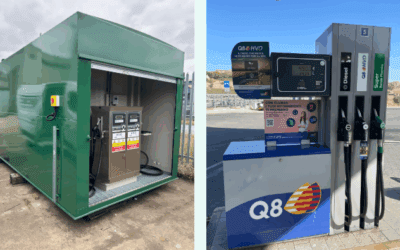Master 2030: Why Choose HVO Fuel for Public Sector Fleets

The transport landscape is rapidly changing, driven by the push to eliminate petrol and diesel vehicles by 2030. Governments worldwide have set ambitious targets to decarbonise transport, with the UK’s Clean Growth Strategy being a notable example. However, as recent industry reports reveal, the shift towards electric vehicles (EVs) is progressing slower than anticipated. Public sector fleet managers face a significant dilemma: how to achieve sustainability goals without sacrificing operational reliability? Fortunately, the HVO fuel transition for public sector fleets offers a viable interim solution that addresses both environmental and operational concerns.
Understanding the 2030 Deadline
The UK government is committed to phasing out petrol and diesel vehicles by 2030 as part of its efforts to achieve net-zero emissions. However, the automotive industry is grappling with several hurdles on the road to EV adoption. According to the International Energy Agency (IEA), the transition to EVs is being slowed by charging infrastructure limitations, availability of materials for battery manufacture , and concerns over vehicle range. Similarly, the Society of Motor Manufacturers and Traders (SMMT) highlights that the current pace of EV uptake is insufficient to meet the 2030 target.
Further complicating the picture, industry experts predict that achieving full electrification will take longer than expected. In fact, “we will be lucky if we get global new car production to 50 per cent electric vehicles by 2045” due to infrastructure and cost challenges, according to The Times. This reinforces the need for alternative solutions like HVO fuel, which can bridge the gap while EV technology catches up.
The Case for HVO Fuel as an Interim Solution
HVO fuel is a renewable diesel alternative produced from waste and residual products, such as used cooking oil. As Neste, a leading HVO producer, demonstrates, HVO offers significant environmental benefits without requiring any modifications to existing diesel engines. This makes it particularly attractive to public sector fleets, which often face budgetary constraints and the need for operational continuity. The HVO fuel transition for public sector fleets allows seamless adoption with minimal disruption.
- Reduced Carbon Emissions: HVO can reduce greenhouse gas emissions by up to 90%, making it a powerful tool in the fight against climate change. By utilising waste materials, HVO also supports the circular economy, further boosting its sustainability credentials and highlighting the importance of the HVO fuel transition for public sector fleets.
- Operational Flexibility: Fleet managers can integrate HVO without investing in new vehicles or charging infrastructure. The Fuel Management Magazine points out that transitioning to HVO can provide substantial benefits without the operational disruptions that often accompany the switch to EVs, making the HVO fuel transition for public sector fleets even more compelling.
- Improved Performance: HVO offers better cold-weather performance compared to traditional diesel, ensuring that public sector vehicles remain operational even in harsh conditions. Additionally, its higher cetane number results in improved combustion efficiency, which leads to reduced engine wear and lower maintenance costs, further enhancing the value of the HVO fuel transition for public sector fleets.
Challenges in Transitioning to EVs
The slow pace of EV adoption poses significant challenges for public sector fleets. As the IEA and SMMT reports indicate, underdeveloped charging infrastructure and limited EV range make them impractical for long-haul services or emergency vehicles. Moreover, the higher upfront costs of EVs are a major barrier for many budget-conscious public sector organisations.
By contrast, HVO offers a cost-effective solution that can be implemented immediately. Public sector fleets, such as Royal Mail, which has already used over 10 million litres of HVO fuel to reduce its CO2 emissions by 30,000 tonnes, provide a compelling case study. Similarly, Falkirk Council’s successful HVO fuel transition for public sector fleets demonstrates the practicality of this fuel for local government operations.
How Public Sector Fleets Can Prepare for 2030
With the 2030 deadline looming, public sector fleets need to take decisive action to meet their sustainability targets. While the future may belong to EVs, the HVO fuel transition for public sector fleets can provide a crucial bridge in the interim.
- Evaluate Fleet Composition: Decision-makers should assess their fleets to identify where HVO can be most effectively integrated. Vehicles that currently run on diesel can switch to HVO with minimal modifications, helping to meet decarbonisation targets while avoiding the delays associated with waiting for EV infrastructure to develop.
- Long-term Strategy: Public sector organisations should adopt a flexible, phased approach, incorporating HVO into their medium-term strategy while continuing to monitor advancements in EV technology. This approach will enable public fleets to comply with evolving regulations without sacrificing operational efficiency, ensuring a smooth HVO fuel transition for public sector fleets.
- Partner with Suppliers: Establishing strong partnerships with HVO suppliers, will ensure a steady supply of renewable fuel. Working with suppliers and industry bodies like the Energy Saving Trust can also provide valuable insights on optimising fleet performance as part of the HVO fuel transition for public sector fleets.
Conclusion
As the race to decarbonise transport intensifies, public sector fleets face complex challenges. While the transition to electric vehicles is essential for the long term, the road to full EV adoption is fraught with obstacles. Charging infrastructure and vehicle range limitations, as well as the slow pace of technological development, mean that EVs are not yet a fully feasible option for many public sector operations.
The HVO fuel transition for public sector fleets offers a pragmatic, immediate solution, allowing fleet managers to reduce emissions without disrupting daily operations. By transitioning to HVO, public sector organisations can take meaningful steps towards achieving their environmental goals while setting a strong example for others to follow. As EV infrastructure and technology evolve, HVO will serve as the bridge that keeps public sector fleets sustainable, cost-effective, and future-ready.








